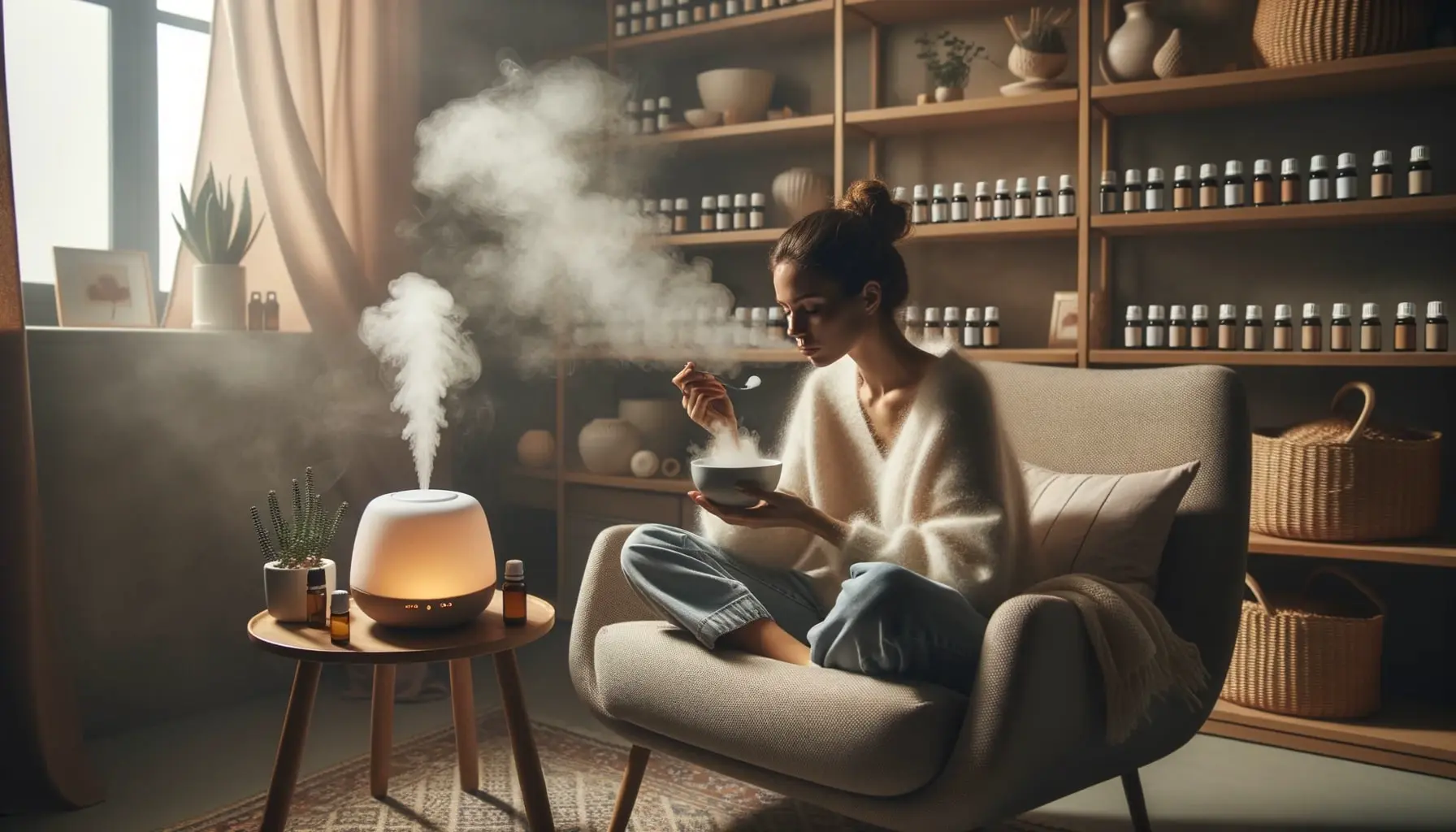Essential oils have garnered significant attention in recent times, becoming a pivotal element of holistic and alternative medicine. With a history spanning centuries, these concentrated plant extracts have proven their mettle in promoting wellness and healing.
What are Essential Oils?
Essential oils are nature’s gift to humanity, encapsulating the true essence of the plants from which they are derived. These potent concentrates carry the natural aroma and flavor of their source, obtained through meticulous processes of distillation or cold pressing.
The result is a highly concentrated liquid that harnesses the therapeutic properties of the plant. Aromathérapie (in French), the art of using these plant oils for healing and wellness, taps into the aromatic compounds of essential oils, employing them in various ways to boost both physical and mental well-being.
When you open a bottle of essential oil, you are greeted with a burst of fragrance, a complex symphony of compounds that holds the power to relax, rejuvenate, and restore. From the calming embrace of lavender to the invigorating zest of lemon, essential oils are a versatile tool in the pursuit of holistic wellness. By understanding their properties and learning how to use them safely, you can unlock a world of natural remedies that complement traditional medicine and enhance your quality of life.
The Multifaceted Benefits of Essential Oils
The benefits of essential oils are as diverse as the oils themselves. Each drop is a potent elixir, capable of addressing a multitude of health concerns. For those seeking relaxation and stress relief, oils like lavender and chamomile are renowned for their calming effects. They create an oasis of tranquility, helping to ease the mind and soothe the spirit. For the sleep-deprived, essential oils offer a natural remedy to encourage restful slumber, with blends designed to calm the mind and relax the body.
When it comes to boosting immunity and fending off illness, essential oils stand as powerful allies. Eucalyptus and tea tree oil, with their antiviral and antibacterial properties, are widely used to support the immune system and maintain respiratory health. They clear congestion, ease breathing, and provide a refreshing boost to the weary.
And for those battling pain and inflammation, the analgesic properties of oils like peppermint and frankincense offer natural relief, reducing discomfort and promoting healing. Whether applied topically or diffused into the air, these oils work synergistically with the body, enhancing its natural ability to heal and maintain balance.
Starting Your Aromatherapy Adventure: Tips for Beginners
Embarking on your aromatherapy journey can be as exciting as it is overwhelming. With a plethora of oils to choose from and myriad ways to use them, where does one begin? Fear not, for we have compiled a list of tips to help you navigate the aromatic waters and start your journey with confidence.
First and foremost, prioritize quality. The market is flooded with essential oils, but not all are created equal. Seek out oils that are 100% pure, free from additives and synthetic fragrances. A good quality oil preserves the integrity of the plant’s properties, ensuring that you reap the full benefits of aromatherapy.
Next, simplify. You don’t need an extensive collection to start; a few versatile oils can go a long way. Lavender, peppermint, and lemon are excellent choices for beginners, each offering a wide array of uses and benefits. Familiarize yourself with these staples, and you’ll soon discover the versatility and potency of essential oils.
And finally, embrace the tools of the trade. A diffuser is a fantastic investment for anyone delving into aromatherapy. It disperses the oils into the air, transforming your space into a fragrant sanctuary and allowing you to inhale the therapeutic compounds of the oils. Remember, the journey into aromatherapy is a personal one, tailored to your needs and preferences. Take your time, experiment, and most importantly, enjoy the aromatic adventure that awaits.
Discovering the Diversity of Essential Oils
Essential oils come in an extensive variety of scents and properties, each offering unique benefits for your body and mind. Let's delve deeper into some of the most popular and versatile oils available, helping you to expand your aromatherapy repertoire and harness their full potential for wellness.
Lavender: The All-Rounder
Lavender oil is renowned for its calming and soothing properties, making it a favorite among aromatherapy enthusiasts. It’s derived from the flowers of the Lavandula angustifolia plant and has a sweet, floral scent. Lavender oil is particularly beneficial for promoting relaxation and improving sleep quality. You can add a few drops to your diffuser before bedtime to create a tranquil environment or mix it with a carrier oil and apply it topically to your temples and wrists. Lavender also has anti-inflammatory and antimicrobial properties, making it a great choice for skin care. Add it to your lotion or use it in a DIY face mask to reap its benefits.

Peppermint: Invigorating and Refreshing
Peppermint oil, with its strong, minty aroma, is perfect for invigorating the senses and boosting mental clarity. It’s extracted from the leaves of the Mentha piperita plant and has a cooling effect when applied to the skin. Peppermint oil is also known for its ability to alleviate headaches, improve digestion, and reduce muscle pain. To use, dilute a few drops with a carrier oil and massage onto the affected area, or add it to your diffuser for a refreshing boost throughout the day.
Eucalyptus: Clearing and Healing
Eucalyptus oil has a fresh, camphorous scent and is well-known for its respiratory benefits. It’s derived from the leaves of the Eucalyptus tree and is excellent for clearing congestion and boosting immune function. Add a few drops to a bowl of hot water and inhale the steam to help clear your sinuses, or use it in a diffuser to purify the air in your home. Eucalyptus oil also has anti-inflammatory and analgesic properties, making it a great option for pain relief.
Tea Tree: Nature’s Antiseptic
Tea tree oil is a powerful antimicrobial, making it a staple in many natural medicine cabinets. It’s derived from the leaves of the Melaleuca alternifolia tree and has a fresh, medicinal scent. Tea tree oil is commonly used to treat acne, fungal infections, and wounds. To use, dilute a drop or two with a carrier oil and apply directly to the affected area. You can also add a few drops to your shampoo or face wash for an added antimicrobial boost.
Practical Application of Essential Oils
Now that you have a better understanding of some of the most popular essential oils and their uses, let’s explore the various ways you can incorporate them into your daily routine for enhanced wellness.
Inhalation: Breathing in the Benefits
Inhalation is one of the most common methods of using essential oils. You can simply add a few drops of your chosen oil to a diffuser and let the aroma fill your space. Alternatively, you can inhale the oils directly from the bottle or add a drop to a tissue and breathe in deeply. Inhalation allows the therapeutic compounds in the oils to enter your bloodstream quickly, providing rapid relief and benefits. You can also use a diffuser for oil essentials to smell them.
Topical Application: Directly to the Source
Essential oils can also be applied directly to the skin, providing targeted relief for various ailments. Always dilute the oils with a carrier oil before applying to avoid skin irritation. You can use essential oils for massage, add them to your skincare routine, or apply them to specific areas for pain relief. Remember to perform a patch test before applying oils to larger areas of your skin to ensure you don’t have an adverse reaction.
Navigating Quality and Safety
When delving into the world of essential oils, it’s crucial to prioritize quality and safety. Always choose 100% pure, therapeutic grade oils to ensure you’re getting the best possible product. Be wary of oils that are labeled as “fragrance oils” or “perfume oils” as these are not pure essential oils and may contain synthetic ingredients.
Finding Reliable Sources
To find high-quality essential oils, do your research and choose reputable brands. Look for companies that provide detailed information about their sourcing and distillation processes, and check for reviews from other customers. The blog at Young Living offers a wealth of information on essential oil quality and safety, helping you make informed decisions about the products you choose.
Advanced Aromatherapy: Unleashing the Full Potential of Essential Oils
Embarking on the journey of aromatherapy opens up a world of possibilities for enhancing well-being, and as you become more familiar with the basics, you may be eager to explore advanced techniques and recipes. In this final section of our guide, we’ll delve into some sophisticated methods of using essential oils and share some of our favorite blends for various purposes.
Creating Synergistic Blends
Synergy occurs when the combination of oils creates a blend that is more effective than the individual oils on their own. Creating synergistic blends requires an understanding of the properties of different oils and how they interact with each other. Start with a base note, such as cedarwood or sandalwood, add a middle note, such as lavender or rose, and finish with a top note, such as bergamot or lemon. Experiment with different combinations until you find a blend that resonates with you and addresses your specific needs.
Recipe for Relaxation
Try this calming blend to unwind after a long day:
- 3 drops Lavender (calming, soothing)
- 2 drops Bergamot (uplifting, balancing)
- 1 drop Ylang Ylang (relaxing, mood-enhancing)
Blend the oils together and add to your diffuser or dilute with a carrier oil and apply to your wrists and temples.
Recipe for Focus and Clarity
Boost your concentration and mental clarity with this invigorating blend:
- 2 drops Peppermint (refreshing, stimulating)
- 2 drops Rosemary (mental clarity, focus)
- 1 drop Lemon (uplifting, purifying)
Combine the oils and use in a diffuser or dilute with a carrier oil for topical application.
Embracing Aromatherapy as a Lifestyle
Aromatherapy is a versatile and holistic practice that can significantly enhance your well-being. By understanding the properties of different essential oils, mastering advanced techniques, and exploring various methods of application, you can unlock the full potential of these powerful botanicals.

Embracing Wellness and Balance
Aromatherapy offers a natural and holistic approach to wellness, providing tools to balance the mind, body, and spirit. By embracing this practice, you are taking a proactive step towards a healthier, more balanced life. Remember to source high-quality oils, practice safe usage, and listen to your body as you explore the aromatic world of essential oils.
Thank you for joining us on this journey through the basics and beyond aromatherapy. We hope this guide has inspired you to explore the world of essential oils and incorporate them into your wellness routine. Stay tuned to Mediwise France for more tips, tricks, and insights on living a balanced and aromatic life. Let's go to a shop and buy charmed aromas in France. Happy oiling!

 Bonjour! I am Mathieu Lefebvre, I am a French national taking medicine in the United States. I took a great interest in alternative medicine since they are very prevalent here in the United States than in my native country! Though they are not really taught in our school that extensively, I find myself learning about them for the sake of knowledge!
Bonjour! I am Mathieu Lefebvre, I am a French national taking medicine in the United States. I took a great interest in alternative medicine since they are very prevalent here in the United States than in my native country! Though they are not really taught in our school that extensively, I find myself learning about them for the sake of knowledge!